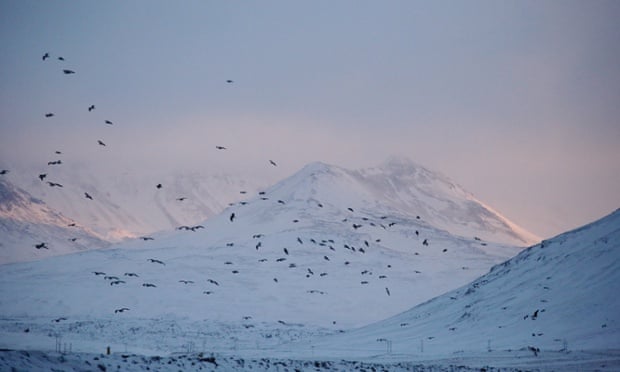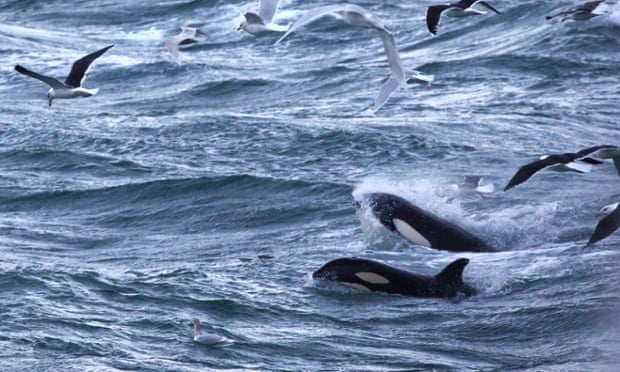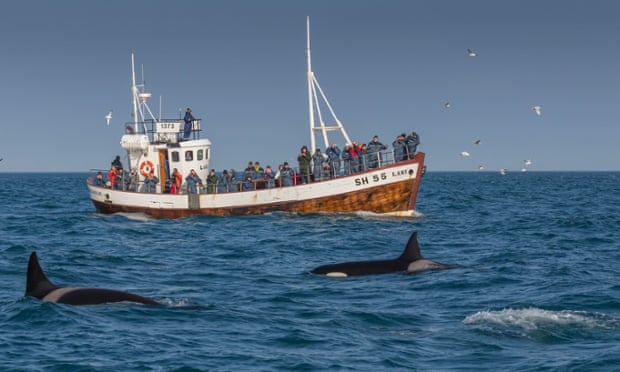Killer whale-watching in West Iceland
Kevin Rushby from The Guardian came to Grundarfjörður to explore the Killer whale
Wildlife guide Marie and boat captain Skarphédinn came down to the hotel that morning to apologise: “The trip is postponed – the weather is just too bad, and tomorrow is going to be worse.”
It was almost noon and just light. We stood in the hotel doorway looking out to where the mountains should be. There was only a blank white wall. A snowplough emerged from it and lumbered past us. The temperature was -7C, spiced up by a 30mph wind blasting flurries of ice particles at anyone who dared go out.
There was no point wondering if it might perhaps calm down later: there is very little “later” in northern Iceland in winter, because the day is just three hours long.

Mountains near Grundarfjördur, northern Iceland, where the daylight only lasts for three hours in winter. Photograph: Kevin Rushby
It’s a risk you take with the frozen north in winter: storms close roads and airports, boats stay tied up and plans go awry. But I only had two days to see what I had come for: the Grundarfjördur killer whales, a sensational gang of marauding orcas whose existence is only just being documented. Four years ago they were noticed, hanging out off this tiny Icelandic town in winter, feasting on herring. A couple of years later local fishermen and brothers, Skarphédinn (Skappi for short) and Gísli Ólafsson, started taking the occasional visitor out. Now they have brought in a killer whale expert, Marie Mrusczok, who is slowly working out what is going on.
“They are here all year,” she tells me, “but in winter they come in close and we do see them a lot from the boat and the shore: February and March are best. Once we had about 100 of them in one place, but usually we see small pods of two or more.”
Marie’s laptop gives me an idea of what I am missing: incredible shots of orcas. “They love synchronicity,” she says. “I’ve seen them all spyhop [raise their heads out of the water] at one time, all leap at one time, all dive. They are so closely in tune with each other.”

The orcas gorge themselves on herring shoals, accompanied by sea birds. Photograph: Kevin Rushby
These are animals that stay together for life and show remarkably caring behaviour. But they are also top predators: curious, playful and deadly. They can snatch other marine mammals and toss them around like basketballs. In the wild, they are remarkably tolerant of humans and have never been known to kill swimmers or divers.
Unfortunately, humans are not so kind to orcas: pollutants and declining fish stocks, especially salmon in the North Pacific, are thought to be causing population declines in several regions.
“I couldn’t believe it when I saw these orcas,” says Marie. “They are fat and healthy.” It also helps that Gísli and Skappi are determined not to disturb the orcas, something Marie is currently researching.

Local fishermen have started taking visitors out to view the orca pod
Skapti suggests we drive to a nearby bridge from which they can sometimes be spotted. That bit of road is still open, rising up out of town past frozen blue-ice waterfalls, over a hillside with a view of a fjord, then down to a long, low concrete bridge that spans the mouth of that fjord. When we get there it doesn’t look promising, but there are a few sops for me: a handful of curious seals, a gyrfalcon, and rafts of eider ducks. No orcas today, the day that is already fading. We return to the viewpoint up on the hill and for a second, a magical second only, we spot three fins far out in the fjord
“You can’t expect too much,” said Marie, philosophically, “Sometimes they feed out there and this is as close as we get.”
Darkness and more bad weather come. I retire to the warmth of the hotel’s outdoor hot tub, wearing a hat against the snow. For a moment the weather lifts and I get an ethereal view of Kirkjufell, the spectacular mountain that hangs over Grundarfjördur.
If I grumble about the weather in the bar later, the truth is I love the atmosphere of this sublime landscape of soft shapes and savage winds, and I’ve seen killer whales – a kilometre away, but I saw them.
Next day is my last and, whatever the temperature, I’m determined to sit out the three hours of daylight at the bridge. At 11.30am I fill up with diesel, throw in some coffee and cakes from the town’s only open shop, and set out.
There will be killer whales, I tell myself over and over as I drive up to the viewpoint. Snow flurries are flicking across the road like mares’ tails as I reach where I think the viewpoint is. There’s the pull-in. I pull in.

The bridge at Grundarfjördur is an ideal viewpoint. Photograph: Kevin Rushby
I know instantly that I’ve made a bad mistake. The car gives a kind of sad sigh and sinks sideways off the road into deep snow. I come to a halt at a 45-degree angle. I’ve turned too early.
There is not a lot of traffic on Iceland’s lonelier roads. I spend an hour digging with my hands and failing to drive out. No one comes. The coffee and cakes are good. I walk down the road until I find a signal and ring the hotel. “Don’t worry,” they tell me. “Someone will come.”
Another hour goes by. I walk to the view over the fjord with my binoculars and far away, through the tears that are whipping from my eyes in the brutal wind, I think I can see thousands of sea birds milling about over the bridge. I wipe my eyes. Is that a fin?
Then Frederick comes. He has a big tractor. He pulls the car out of the snow drift like a cork from a bottle, shakes my hand and chugs away. I leap in and drive as fast as I dare down to the bridge.
What I see over the next hour is one of the greatest wildlife experiences I’ve ever had. The birds are in a frenzy because a pod of orcas is gorging on a herring shoal all around the bridge. There are no jumps, just some happy tail slaps – reminders for the herring to stay in a nice tight ball – easier for them to swallow.

Scientists have only recently been studying the behaviour of the Grundarfjördur orca pods
The gulls are grabbing crumbs from a killer whale table. Again and again a huge black-and-white shape looms beneath my feet, bursts out for a breath, surfs a bit of swell, then dives away again.
I am closer to the orcas than you could ever hope to be at one of those dodgy aquarium shows. The light is borderline for photography, but I can see their eyes as they roll a bit, maybe trying to catch a glimpse of the peculiar creatures above them. Then with a few farewell tail slaps, they are gone: some off into the fjord, others out to sea.
I drive away in a pinkish twilight, through fields of twisted lava. Grundarfjördur: my favourite bridge ever! Be patient. Take binoculars, handwarmers and a thermos. Don’t expect too much.
• The trip was provided by Discover the World (01737 214291, discover-the-world.co.uk), whose three-night Killer Whales and Northern Lights Self Drive trip costs from £643pp, including return flights with Icelandair from London, Manchester or Glasgow, three nights B&B at Hotel Framnes, one whale-watching boat trip and car rental. Departures from December to March; escorted tours with a specialist guide are available from January

